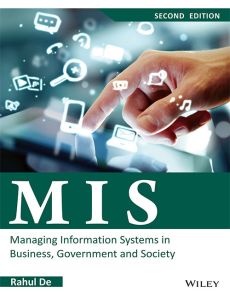MIS: Managing Information Systems in Business, Government and Society, 2ed
ISBN: 9788126571222
556 pages
eBook also available for institutional users
For more information write to us at: acadmktg@wiley.com

Description
Information technology (IT) defines the manner in which organisations and businesses operate and compete. The role of the modern manager is to both manage IT and to harness its immense potential for innovation and growth. The purpose of this book is to understand the decisions managers have to make with regard to IT and innovating with IT. This book explains key technologies that constitute the modern IT landscape and also explores the manner in which IT shapes the world around us. The discussions, examples and cases are drawn largely from the Indian context, though their relevance and scope is universal.
Teaching with this Book
Special Features of the
Organisation of the Book
About the Author
List of Figures
List of Tables
Part I MIS And Organisations
Chapter 1 Organisations and Information Systems
1.1 Modern Organisation
1.2 Information Systems in Organisations
1.3 Brief History of Computing
1.4 The Role of the Internet
1.5 Managing in the Internet Era
1.6 Managing Information Systems in Organisations
1.7 Challenges for the Manager
Chapter 2 IT and Innovation
2.1 Innovation Theory
2.2 Innovation Impact
2.3 Types of Business Innovations with IT
2.4 Management Issues: Challenges for Managers
Chapter 3 Concepts of Management Information Systems
3.1 Data and Information
3.2 Information as a Resource
3.3 Information in Organisational Functions
3.4 Types of Information Technology
3.5 Types of Information Systems
3.6 Decision Making with MIS
3.7 Communication in Organisations
Chapter 4 IT Strategy and Digital Goods
4.1 The Competitive Environment of Business
4.2 Using IT for Competing
4.3 Information Goods
4.4 Information Systems and Competitive Strategy
Chapter 5 Electronic Commerce, Electronic Business, Electronic Governance
5.1 E-Commerce Technology
5.2 HTML and Email
5.3 Doing Business over the Internet
5.4 E-Business
5.5 E-Governance
Chapter 6 Managing Information Systems
6.1 Challenges of Managing the IT Function
6.2 Vendor Management
6.3 The Role of the CIO
6.4 IT Governance
Chapter 7 Ethical and Social Issues
7.1 Ethical Issues
7.2 Social Issues
7.3 Dark Side of IT
Chapter 8 Managing Green IT and Smart Cities
8.1 Introduction: The Green Imperative
8.2 Greenhouse Gases and Global Warming
8.3 Carbon Footprint
8.4 What is Green IT?
8.5 Green Practices in Hardware Design and Manufacture
8.6 Green Practices in Software Design
8.7 Green Practices in IT Use
8.8 IT for Green Practices
8.9 Monitoring Value Chain Activities
8.10 Smart Cities
8.11 Management Issues: Challenges for Managers
Part II Fundamentals Of IT
Chapter 9 Information Technology Infrastructure and Choices
9.1 What is the IT Infrastructure?
9.2 IT Infrastructure Decisions
9.3 Infrastructure Components
9.4 Networks
9.5 Solutions
Chapter 10 Cloud Computing and Internet-of-Things
10.1 Cloud Computing
10.2 Internet-of-Things
10.3 Challenges of Cloud Computing and IoT
Chapter 11 Networking and Telecommunication
11.1 Life of a Packet
11.2 Structure of the Network
11.3 Network Services and Layers
Chapter 12 Information Systems Security and Control
12.1 Threats to the Organisation
12.2 Technologies for Handling Security
12.3 Managing Security
Chapter 13 Information Systems Development and Project Management
13.1 Analysis of Business Processes
13.2 Life Cycle Models
13.3 Software Project Management
Chapter 14 Managing Data Resources
14.1 The Need for Data Management
14.2 Challenge of Data Management
14.3 Database Concepts
14.4 Database Design
14.5 Data Warehouses
14.6 Big Data
Chapter 15 Business Process Integration and Enterprise Systems
15.1 Business Process Integration
15.2 Motivation for Enterprise Systems
15.3 Enterprise Resource Planning Systems
15.4 Supply Chain Management Systems
15.5 Customer Relationship Management Systems
15.6 Challenges of Enterprise Systems Implementations
15.7 International Information Systems
Chapter 16 Decision Support Systems
16.1 Decision Support Systems
16.2 Components of a DSS
16.3 Analytics and Business Intelligence
16.4 Knowledge Management
Chapter 17 Artificial Intelligence
17.1 Introduction and History of AI
17.2 The Turing Test
17.3 Representation and Search
17.4 Machine Learning
17.5 Implications for Managers
Part III Social Aspects Of IS
Chapter 18 ICT for Development and E-Governance
18.1 ICT for Development
18.2 Types of ICT Interventions
18.3 Examples of ICT for Development Projects
18.4 E-Governance Concepts
18.5 E-Government
18.6 E-Participation
Chapter 19 The Society of the Internet
19.1 Social Dynamics of the Internet
19.2 Services of the Internet
19.3 Technology of the Internet
19.4 Social Issues
19.5 Social Networks in the Enterprise
Chapter 20 Open Source Software
20.1 The Concept of Open Source Software
20.2 Open Source Licences
20.3 Open Source in Business and Government
20.4 Open Data Standards and the Open Community
Chapter Glossary
Review Questions
Research Questions
Further Reading
Appendix A
Appendix B
Index




